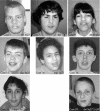Array-based comparative genomic hybridisation identifies high frequency of cryptic chromosomal rearrangements in patients with syndromic autism spectrum disorders
- PMID: 16840569
- PMCID: PMC2563185
- DOI: 10.1136/jmg.2006.043166
Array-based comparative genomic hybridisation identifies high frequency of cryptic chromosomal rearrangements in patients with syndromic autism spectrum disorders
Abstract
Background: Autism spectrum disorders (ASD) refer to a broader group of neurobiological conditions, pervasive developmental disorders. They are characterised by a symptomatic triad associated with qualitative changes in social interactions, defect in communication abilities, and repetitive and stereotyped interests and activities. ASD is prevalent in 1 to 3 per 1000 people. Despite several arguments for a strong genetic contribution, the molecular basis of a most cases remains unexplained. About 5% of patients with autism have a chromosome abnormality visible with cytogenetic methods. The most frequent are 15q11-q13 duplication, 2q37 and 22q13.3 deletions. Many other chromosomal imbalances have been described. However, most of them remain undetectable using routine karyotype analysis, thus impeding diagnosis and genetic counselling.
Methods and results: 29 patients presenting with syndromic ASD were investigated using a DNA microarray constructed from large insert clones spaced at approximately 1 Mb intervals across the genome. Eight clinically relevant rearrangements were identified in 8 (27.5%) patients: six deletions and two duplications. Altered segments ranged in size from 1.4 to 16 Mb (2-19 clones). No recurrent abnormality was identified.
Conclusion: These results clearly show that array comparative genomic hybridisation should be considered to be an essential aspect of the genetic analysis of patients with syndromic ASD. Moreover, besides their importance for diagnosis and genetic counselling, they may allow the delineation of new contiguous gene syndromes associated with ASD. Finally, the detailed molecular analysis of the rearranged regions may pave the way for the identification of new ASD genes.
Conflict of interest statement
Competing interests: None declared.
References
-
- Association A P.Diagnostic and statistical manual of mental disorders. 4th edn. Washington, DC: APA, 1994
-
- Fombonne E. The prevalence of autism. JAMA 200328987–89. - PubMed
-
- Volkmar F R, Lord C, Bailey A, Schultz R T, Klin A. Autism and pervasive developmental disorders. J Child Psychol Psychiatry 200445135–170. - PubMed
-
- Fombonne E. Epidemiological surveys of autism and other pervasive developmental disorders: an update. J Autism Dev Disord 200333365–382. - PubMed
-
- Alsdorf R, Wyszynski D F. Teratogenicity of sodium valproate. Expert Opin Drug Saf 20054345–353. - PubMed
Publication types
MeSH terms
Grants and funding
LinkOut - more resources
Full Text Sources
Other Literature Sources
Miscellaneous


